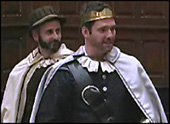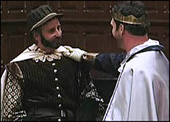- Edition: King Leir
King Leir
- Introduction
- Texts of this edition
- Contextual materials
- Facsimiles
36King Leir, Scene 4
Cast
Mumford: Alon Nashman
Gallian King: Paul Hopkins
French Lord: Scott Maynard
Queen's Men Dramaturgy: Medley Style (Sc. 4)
Read about Queen's Men medley style in Scene 3
37In relation to the other plays performed in the original SQM productions King Leir is comparatively consistent in style, the regularity of the versification creates this illusion. Variety remains a guiding principle in the Queen's Men's dramaturgy in this play and Scene 4 steers the action away from the serious matter featured in the play up to this point. On the page, little appears to be happening, but the SQM actors gave the scene a playful quality that brought the scene to life,raising expectations of future fun while launching the storyline that would eventually bring the play to its happy conclusion.
Performing The Gallian King (Sc. 4)
38 Paul Hopkins, as the Gallian King, brought youthful charisma to the role, focusing on the king's desire for adventure and fun, and his apparent love of disguises seen here (TLN 384) and in scene 21 (TLN 1867). By focusing on the king's adventurous youth, he helped to separate the QM play from the subsequent Shakespearean associations with the King of France. Shakespeare's King of France provides the play with an example of magnanimity, he is a man willing to marry Cordelia for her virtue alone. The Gallian King does the same but from a different context - his character is derived from chivalric romance and has more akin with the wandering knights Sir Clyomon and Sir Clamydes than with the noblemen who populate Shakespeare's history plays and tragedies. Hopkins played this scene as if the business of kingship were a burdensome inconvenience to the romantic king who was impatient to leave his land, councilors, and responsibilities behind and embark on a grand quest for love.
Read more about performing the Gallian King in the SQM production.
Watch video of scene 4 on the Performing the Queen's Men website. (The video footage is password protected. Click on "Cancel" in the pop-up window to obtain password.)
Performing Mumford (Sc. 4)
39 One of the premises of the SQM productions was that the three plays could have formed part of the Queen's Men's repertoire in the 1580s and might all have been performed by the same company of actors. This premise is impossible to prove but it was a determining factor in our casting process. We adopted the principle that actors would have specialized parts and would have taken on similar roles from play to play. One of our master actors was assigned to play the lead comic roles in each play, roles we imagined might have been performed by the famous clown actor Richard Tarlton in the original productions. Current critical understanding suggested that Tarlton specialized in working class characters. In fact the term 'clown' had double meaning in his day referring to the principal comedian in a theatrical company and to real-life country rustics. We know with a degree of certainty that the role of Derrick in Famous Victories, was performed by Tarlton. Derrick is a typical example of the 'clown' character that according to legend was popularized by Tarlton; this clown is a country bumpkin newly arrived in the city.
40 The choice of clown role was less obvious in King Leir. The witty Mumford, a jovial French courtier, seems an unlikely role for an Elizabethan clown but working on the role with our own company clown, Alon Nashman, revealed telling points of connection that suggest that Mumford may indeed have been a part for Tarlton. In this scene, for example, Mumford identifies his kinship with the English noble Blunt family, who, in keeping with their name, he defines in terms of their plain-speaking (TLN 388) and the prose he adopts to suit his disguise bears marked resemblance to the language of Derrick and other 'clown' characters.
41Imagining Tarlton playing this role adds a satisfying level of irony to the character, enhancing the comedy and establishing a playful, teasing relationship between the world of the play and the world of the Elizabethan audience. Mumford's assertion, for example that the French dames are more beautiful than the English (TLN 358-361) would have been given an amusing twist if spoken by the archetypically English clown. Indeed, the very idea of the familiar English clown playing a French courtier would have amused on a meta-theatrical level with audience and actor both enjoying the atypical casting.
42 The association with Tarlton aside, conceiving this character as a role for a principal comedian is essential to understanding the dramaturgy of the play. Mumford and his king become active agents in the unwinding of the plot and enable its turn from desperation to hope and a happy resolution. Their fun-loving desire for romantic adventure and "pleasant company" (TLN 390) is central to the spirit of the play and serve as an important contrast to the sour envy and vindictiveness of Ragan and Gonorill.
Read more about performing Mumford in the SQM production.
Watch video of Scene 4 on the Performing the Queen's Men Website. (The video footage is password protected. Click on "Cancel" in the pop-up window to obtain password.)





